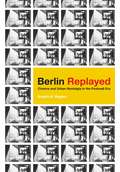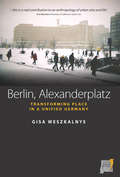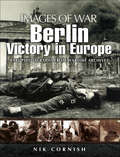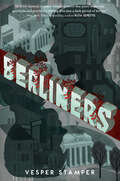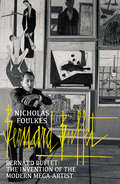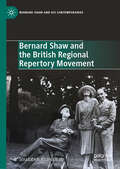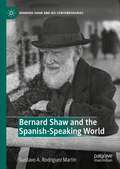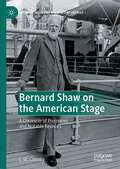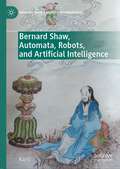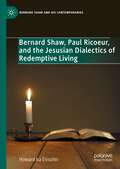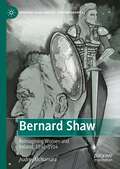- Table View
- List View
Berkshire County's Industrial Heritage (Images of America)
by John S. DicksonEvidence of bygone industrial prowess is scattered across Berkshire County in the far west of Massachusetts. Better known now for its four-season tourist attractions like beautiful scenery, cultural venues, and outdoor sports, the region was once home to an industrial base that helped a growing nation meet its needs in textiles, paper, glass, iron, and a variety of other products. The relics—imposing brick buildings just off the main roads—tell a story of enterprising young men and women harnessing the power of the area’s rushing streams to make products and profits. They were inventors and adopters of technology, and they gave back to their communities. Recurring waves of immigrants flowed into the county to take their places at the machinery and try to make a living for their families.
Berlin
by Kathleen L. MurrayLocated in the geographical center of the state, Berlin is best known as the Home of the Yankee Peddler. The first white settler, John Beckley, arrived in 1650, followed by a few families from Farmington in the late 1600s. Initially, Berlin was both a religious and an agrarian community. Farming was the way of life when the first church was built in 1712 in the Great Swamp Settlement of Berlin. As the settlement grew, small industries arose, mills sprang up along the rivers and streams, tinsmith shops opened, and the Yankee peddler wagon became a traveling store. Gradually over the years, the industries expanded and the farms diminished.Berlin focuses on the townspeople-the doctors and merchants, artists and artisans, poets and painters. The town has three population centers: East Berlin is separated from Kensington and Berlin by a highway and a line of hills, and each of these sections has retained its villagelike atmosphere. The book highlights the diversity of Berlin's religious community and the spirit of ecumenicalism that spread throughout its neighborhoods. Individuals who appear include the Leatherman, a gentle person who traveled through Berlin in ages past, and the Goat Man, the personification of the kind neighbor. Dr. Willard Wallace said it very well, "Berlin is just Berlin . . . people of many different religious and ethnic backgrounds who live successfully together."
Berlin (Images of America)
by Berlin History Foundation, Inc. Susan TaylorThe town of Berlin on Maryland's Eastern Shore was founded on a 300acre tract of land called Burley, part of a land grant to Col. William Stevens that was surveyed in 1677. The town developed on the crossroads of the Sinepuxent Road, going east toward the Atlantic coast and the Philadelphia Post Road, and derived its name from the contraction of Burley Inn, a roadside inn at this popular crossroads. One of Berlin's famous locals was United States naval hero Stephen Decatur, who was born on farm property within the surrounding area in 1779. Today Berlin's Main Street is listed on the National Register of Historic Places, and the town has received national attention by having been featured in both Paramount Pictures' Runaway Bride (1999) and Disney's Tuck Everlasting (2002) films.
Berlin (Postcard History Series)
by Jacklyn T. NadeauBerlin, first settled in 1822 by William Sessions of Gilead, Maine, began as Maynesborough and was incorporated as the town of Berlin in 1829. The invention of the water turbine allowed early residents to harness the immense power of the Androscoggin River, which bisects the town. The arrival of the railroad in 1852 aided the transport of timber and later paper products, helping to give Berlin the nickname "the City that Trees Built." Incorporated as a city in 1897, what began as a small town grew until it was, for a time, the world's largest manufacturer of paper products.
Berlin Before the Wall: A Foreign Student's Diary with Sketches (Routledge Revivals)
by Hsi-Huey LiangIn the 1950’s, Berlin had come under four-power occupation while still struggling to recover from the war. It had also become the object of a fierce ideological conflict between Stalinist Communism and capitalist democracy, between traditional German values and hopes for a new and better Europe. From these years, when the inhabitants of Germany’s Old Reich capital re-evaluated their past and tried to set their hopes for the future, comes the diary of an expatriate Chinese student, himself in search of a new spiritual homeland and as anxious to learn from the victors as from the vanquished.First published in 1990, Berlin Before the Wall is an account of life in Berlin recorded in the form of a diary and sketchbook kept by Hsi-Huey Liang, a young graduate student, while researching his dissertation in 1954. Capturing a pivotal moment of the Cold War, Liang provides a wealth of detail about a city that has been the subject of enduring fascination. As a historical document, the diary records the political events of the time with an engaging style and compelling immediacy. As a sketchbook, it captures the rhythms of the city, with its witty pencil drawings of people, places, and events. Liang’s pencil moves with ease and intelligence from street cleaners to diplomats, and his drawings exhibit not only an extraordinary sensitivity but are also astonishing in their sheer variety and keen insight into the culture of Berlin.This book will be a fascinating read for anyone interested in the Cold War period, student life, and all things German.
Berlin Replayed: Cinema and Urban Nostalgia in the Postwall Era
by Brigitta B. WagnerScarred by the Second World War, divided during the Cold War, and turned into a massive construction site in the early postwall years, Berlin has dramatically reinvented itself in the new millennium. Film has served a neglected but important function in this transformation.In Berlin Replayed, Brigitta B. Wagner shows how old and new films set in Berlin created a collective urban nostalgia for the city&’s best, most inclusive, and most conciliatory pasts in the face of its renewed purpose as the all-German capital. Exploring films such as Walter Ruttmann&’s Berlin: Symphony of a Great City, Wim Wenders&’s Wings of Desire, Tom Tykwer&’s Run Lola Run, and Wolfgang Becker&’s Good Bye, Lenin!, the book establishes that these films don&’t merely feature the city but actively construct how viewers come to know different Berlins of the past and present. To illustrate how film has repeatedly remade the image of the city, Berlin Replayed focuses on four key periods: the golden 1920s, when the city was a major filmmaking center; the prewall 1950s, when Berlin had two ideologically opposed film industries; the politically transformative late 1980s and early 1990s; and the hyped start of the twenty-first century.By showing how films have helped revive memories of the &“good&” Berlin and, by extension, the &“good&” Germany, Berlin Replayed reveals the underappreciated but powerful role film has played in the process of unifying Germany&’s historical experience and bridging its physical and political divisions.
Berlin, Alexanderplatz: Transforming Place in a Unified Germany (Space and Place #1)
by Gisa WeszkalnysA benchmark study in the changing field of urban anthropology, Berlin, Alexanderplatz is an ethnographic examination of the rapid transformation of the unified Berlin. Through a captivating account of the controversy around this symbolic public square in East Berlin, the book raises acute questions about expertise, citizenship, government and belonging. Based on ethnographic fieldwork in the city administration bureaus, developers' offices, citizen groups and in Alexanderplatz itself, the author advances a richly innovative analysis of the multiplicity of place. She reveals how Alexanderplatz is assembled through the encounters between planners, citizen activists, social workers, artists and ordinary Berliners, in processes of popular participation and personal narratives, in plans, timetables, documents and files, and in the distribution of pipes, tram tracks and street lights. Alexanderplatz emerges as a socialist spatial exemplar, a 'future' under construction, an object of grievance, and a vision of robust public space. This book is both a critical contribution to the anthropology of contemporary modernity and a radical intervention in current cross-disciplinary debates on the city.
Berlin: Victory in Europe (Images of War)
by Nik CornishIn April and May 1945 the city of Berlin was the site of the final destructive act of the Second World War in Europe. The German capital became a battleground. After three weeks of ruthless fighting against a desperate, sometimes suicidal, defense, the Red Army took the city and crushed the last remaining German armies in the East. This momentous battle and the elaborate preparations for it were recorded in graphic detail by photographers whose images have come down to us today. These images, which give us an unforgettable glimpse into the grim reality of mid-twentieth-century warfare, are the raw material of Nik Cornishs evocative book.Using a rich selection of rare photographs from the Russian archives as well as images from German sources, most of which have not been published before, he traces the course of the entire campaign. The battles fought in East Prussia, eastern Germany and Hungary in particular the assault on Budapest are covered. But the body of his book is devoted to the battle for Berlin itself—the monstrous onslaught launched by Zhukovs armies on the Seelow Heights, the bitter street fighting through the suburbs, then the ultimate confrontation, the merciless room-by-room struggle for the center of the city and the Reichstag.
Berliners
by Vesper StamperA riveting story about the rivalry between two brothers living on opposite sides of the Berlin wall during its construction in the 1960s, and how their complicated legacy and dreams of greatness will determine their ultimate fate.A city divided. A family fractured. Two brothers caught between past and present.Berlin, 1961. Rudi Möser-Fleischmann is an aspiring photographer with dreams of greatness, but he can't hold a candle to his talented, charismatic twin brother Peter, an ambitious actor. With the sudden divorce of their parents, the brothers find themselves living in different sectors of a divided Berlin; the postwar partition strangely mirroring their broken family. But one night, as the city sleeps, the Berlin Wall is hurriedly built, dividing society further, and Rudi and Peter are forced to choose between playing by the rules and taking their dreams underground. That is, until the truth about their family history and the growing cracks in their relationship threaten to split them apart for good. From National Book Award-nominated, critically acclaimed author-illustrator Vesper Stamper comes a stark look at how resentment and denial can strain the bonds of brotherhood to the breaking point.
Bernard Berenson
by Rachel CohenWhen Gilded Age millionaires wanted to buy Italian Renaissance paintings, the expert whose opinion they sought was Bernard Berenson, with his vast erudition, incredible eye, and uncanny skill at attributing paintings. They visited Berenson at his beautiful Villa I Tatti, in the hills outside Florence, and walked with him through the immense private library--which he would eventually bequeath to Harvard--without ever suspecting that he had grown up in a poor Lithuanian Jewish immigrant family that had struggled to survive in Boston on the wages of the father's work as a tin peddler. Berenson's extraordinary self-transformation, financed by the explosion of the Gilded Age art market and his secret partnership with the great art dealer Joseph Duveen, came with painful costs: he hid his origins and felt that he had betrayed his gifts as an interpreter of paintings. Nevertheless his way of seeing, presented in his books, codified in his attributions, and institutionalized in the many important American collections he helped to build, goes on shaping the American understanding of art today. This finely drawn portrait of Berenson, the first biography devoted to him in a quarter century, draws on new archival materials that bring out the significance of his secret business dealings and the way his family and companions--including his patron Isabella Stewart Gardner, his lover Belle da Costa Greene, and his dear friend Edith Wharton--helped to form his ideas and his legacy. Rachel Cohen explores Berenson's inner world and exceptional visual capacity while also illuminating the historical forces--new capital, the developing art market, persistent anti-Semitism, and the two world wars--that profoundly affected his life.
Bernard Buffet: The Invention of the Modern Mega-artist
by Nicholas FoulkesIt is said that asphyxiation brings on a state of hallucinatory intoxication...in which case the 71 year old artist who lay in his sprawling Provencal villa died happy. In the early afternoon of Monday 4 October 1999, wracked with Parkinson's, and unable to paint because of a fall in which he had broken his wrist, Bernard Buffet calmly placed a plastic bag over his head, taped it tight around his neck and patiently waited the few minutes it took for death to arrive. Bernard Buffet:The Invention of the Modern Mega-artist tells the remarkable story of a French figurative painter who tasted unprecedented critical and commercial success at an age when his contemporaries were still at art school. Then, with almost equal suddenness the fruits of fame turned sour and he found himself an outcast. Scarred with the contagion of immense commercial success no leper was more untouchable. He was the first artist of the television age and the jet age and his role in creating the idea of a post-war France is not to be underestimated. As the first of the so-called Fabulous Five (Francoise Sagan, Roger Vadim, Brigitte Bardot and Yves Saint Laurent) he was a leader of the cultural revolution that seemed to forge a new France from the shattered remains of a discredited and demoralized country. Rich in incident Buffet’s remarkable story of bisexual love affairs, betrayal, vendettas lasting half a century, shattered reputations, alcoholism, and drug abuse, is played out against the backdrop of the beau monde of the 1950s and 1960s in locations as diverse as St Tropez, Japan, Paris, Dallas, St Petersburg and New York, before coming to its miserable conclusion alone in his studio.
Bernard Shaw and Modern Advertising: Prophet Motives (Bernard Shaw and His Contemporaries)
by Christopher WixsonThis book charts how promotional campaigns in which Bernard Shaw participated were key crucibles within which agency and personality could re-negotiate their relationship to one another and to the consuming public. Concurrent with the rise of modern advertising, the creation of Shaw’s 'G.B.S.' public persona was achieved through masterful imitation of patent medicine marketing strategies and a shrewd understanding of the relationship between product and spokesman. Helping to enhance the visibility of his literary writing and dovetailing with his Fabian political activities, 'G.B.S.' also became a key figure in the evolution of testimonial endorsement and the professionalizing of modern advertising. The study analyzes multiple ad series in which Shaw was prominently featured that were occasions for self-promotion for both Shaw and the agencies, and presage the iconoclastic style of contemporary 'public personality' and techniques of celebrity marketing.
Bernard Shaw and Noël Coward: Conversation Pieces (Bernard Shaw and His Contemporaries)
by Christopher WixsonThis book tracks dramaturgical affinities between some of Bernard Shaw&’s late &“extravagant&” plays and those of Noël Coward, in particular their recasting of one another&’s style and the tradition of manners comedy. While Coward&’s first play (The Young Idea) all but plagiarizes You Never Can Tell and Shaw responds with his own depictions of the idle rich, their experimental plays in the 1930s also ambitiously engage issues of race and Empire, topics further outside their respective idioms. &“Christopher Wixson mines Shaw&’s rarely-explored engagement with the work of Noël Coward, examining both writers' highly experimental plays from the 1930s in light of such important issues as postwar disillusionment, racial difference, and post-coloniality.&” Michel Pharand, Queen's University
Bernard Shaw and St. John Hankin: Happy Endings (Bernard Shaw and His Contemporaries)
by Christopher Wixson&“This original study will no doubt draw attention to St. John Hankin&’s work, which may in turn receive further scrutiny from scholars, students, and theatre practitioners.&” Michel Pharand, Queen's University This book proposes a vibrant intertextual dialogue between St. John Hankin&’s manners comedies and what are considered Bernard Shaw&’s &“minor&” Edwardian comedies and, after the war, some of his most experimental &“extravagant&” plays. Engaging thematic topics ranging from philanthropy and parenting to marital alliances and comic endings, their dramaturgy was truly in conversation over form and content as they re-purposed one another in a vital wrangling to direct the creative evolution of modern British comedy.
Bernard Shaw and the British Regional Repertory Movement (Bernard Shaw and His Contemporaries)
by Soudabeh AnanisarabThis book is the first to explore Shaw&’s full involvement with the twentieth-century British regional repertory movement. Using extensive archival research to piece together Shaw&’s connections to regional theatres, this book explores monumental regional productions of Shaw&’s plays and investigates Shaw&’s relationships – both professional and personal – with key figures in the repertory movement. British repertory theatres and companies, with their emphasis on the use of the short run and ensemble acting, played a crucial role in the staging of non-commercial and theatrically experimental work in the early twentieth century. Shaw collaborated extensively with repertory companies, providing them with plays, which offered alternatives to the London trends of the long run and star system. These theatres, in turn, offered Shaw a way to disseminate his radical artistic and political ideas in British locations outside the capital city as well as internationally.
Bernard Shaw and the Censors: Fights and Failures, Stage and Screen (Bernard Shaw and His Contemporaries)
by Bernard F. Dukore“Dukore’s style is fluid and his wit delightful. I learned a tremendous amount, as will most readers, and Bernard Shaw and the Censors will doubtless be the last word on the topic.”- Michel Pharand, former editor of SHAW: The Journal of Bernard Shaw Studies and author of Bernard Shaw and the French (2001). "This book shows us a new side of Shaw and his complicated relationships to the powerful mechanisms of stage and screen censorship in the long twentieth century.” - - Lauren Arrington, Professor of English, Maynooth University, IrelandA fresh view of Shaw versus stage and screen censors, this book describes Shaw as fighter and failure, whose battles against censorship – of his plays and those of others, of his works for the screen and those of others – he sometimes won but usually lost. We forget usually, because ultimately he prevailed and because his witty reports of defeats are so buoyant, they seem to describe triumphs. We think of him as a celebrity, not an outsider; as a classic, not one of the avant-garde, of which Victorians and Edwardians were intolerant; as ahead of his time, not of it, when he was called “disgusting,” “immoral", and "degenerate.” Yet it took over three decades and a world war before British censors permitted a public performance of Mrs Warren’s Profession. We remember him as an Academy Award winner for Pygmalion, not as an author whose dialogue censors required deletions for showings in the United States. Scrutinizing the powerful stage and cinema censorship in Britain and America, this book focuses on one of its most notable campaigners against them in the last century.
Bernard Shaw and the Making of Modern Ireland (Bernard Shaw and His Contemporaries)
by Audrey McNamara Nelson O’Ceallaigh RitschelThis book is an anthology focused on Shaw’s efforts, literary and political, that worked toward a modernizing Ireland. Following Declan Kiberd’s Foreword and the editor’s Introduction, the contributing chapters, in their order of appearance, are from President of Ireland Michael D. Higgins, Anthony Roche, David Clare, Elizabeth Mannion, Nelson O’Ceallaigh Ritschel, Aisling Smith, Susanne Colleary, Audrey McNamara, Aileen R. Ruane, Peter Gahan, and Gustavo A. Rodriguez Martin. The essays establish that Shaw’s Irishness was inherent and manifested itself in his work, demonstrating that Ireland was a recurring feature in his considerations. Locating Shaw within the march towards modernizing Ireland furthers the recent efforts to secure Shaw’s place within the Irish spheres of literature and politics.
Bernard Shaw and the Spanish-Speaking World (Bernard Shaw and His Contemporaries)
by Gustavo A. Rodríguez MartínThis book explores, through a multidisciplinary approach, the immense influence exerted by Bernard Shaw on the Spanish-speaking world on both sides of the Atlantic. This collection of essays encompasses the reception and dissemination of his ideas; the translation of his works into Spanish; the performance history of his plays in Spain and Latin America; and Shaw’s influence on many key figures of literature in Spanish. It begins by delving into Shaw’s knowledge of Spanish literature and gauging his acquaintance with the Spanish cultural milieu throughout his tenure as an art, music, and theatre critic. His early exposure to Spanish-speaking culture later made the return trip in the form of profuse critical reception and theatrical success in countries like Spain, Argentina, Mexico, and Uruguay. This allows for a more detailed investigation into the unmistakable mark that Bernard Shaw left in the oeuvre of leading Spanish-speaking authors like Ramiro de Maeztu, Jorge Luis Borges or Nemesio Canales. This volume also assesses the translations of Shaw’s works into Spanish—while also providing a detailed publication history of these translations.
Bernard Shaw on the American Stage: A Chronicle of Premieres and Notable Revivals (Bernard Shaw and His Contemporaries)
by L. W. ConollyBernard Shaw on the American Stage is the first comprehensive study of the production of Bernard Shaw’s plays in America. During his lifetime (1856-1950), Shaw was America’s most popular living playwright; productions of his plays were outnumbered only by Shakespeare. Forty-four of Shaw’s plays were staged in America before his death, eight more posthumously. Eleven of the productions were world premieres. Bernard Shaw on the American Stage tells the story of the fifty-two premieres, which, apart from a few fragments, is his total dramatic oeuvre. The book also includes, again for the first time, production data and concise overviews of dozens of the most notable American revivals of the plays, from the 1890s to the beginning of the 2020 pandemic. Illustrations—production photographs, programmes, theatre buildings, playbills, actors’ studio portraits— inform the study throughout.
Bernard Shaw, Automata, Robots, and Artificial Intelligence (Bernard Shaw and His Contemporaries)
by Kay LiThis project is the first to explore how Bernard Shaw intersects constructively with automata, robots and artificial intelligence (AI). Shaw was born in the golden age of the automaton. His Bible on the Life Force and Creative Evolution, Back to Methuselah, was written when Karel and Josef Čapek coined the word “robot.” Shaw’s life ran in parallel with the rise of AI, and the big names in AI were his contemporaries. Moreover, empirical analyses of Shavian texts and images using AI uncovers possibilities for new interpretations, demonstrating how future renditions of his works may make use of these advanced technologies to broaden Shaw’s audience, readership and scholarship.
Bernard Shaw, Paul Ricoeur, and the Jesusian Dialectics of Redemptive Living (Bernard Shaw and His Contemporaries)
by Howard Ira EinsohnThis book explores a heretofore unremarked linkage between Bernard Shaw, the twentieth-century French thinker Paul Ricoeur, and Jesus of Nazareth. The ties that bind them are a foundational interest in the social teachings of the Nazarene and their use of a shared dialectics with respect to living the kind of compassionate life that holds out the promise in our contemporary world of achieving something approximating universal wellness on a healthy planet at peace with itself. This work argues that the three principal subjects of the study—independently of one another—used the same dialectical method to reach the same dialectically derived conclusion about how humans can live redemptively in a fractured world.
Bernard Shaw, Sean O’Casey, and the Dead James Connolly (Bernard Shaw and His Contemporaries)
by Nelson O’Ceallaigh RitschelThis book details the Irish socialistic tracks pursued by Bernard Shaw and Sean O’Casey, mostly after 1916, that were arguably impacted by the executed James Connolly. The historical context is carefully unearthed, stretching from its 1894 roots via W. B. Yeats’ dream of Shaw as a menacing, yet grinning sewing machine, to Shaw’s and O’Casey’s 1928 masterworks. In the process, Shaw’s War Issues for Irishmen, Annajanska, the Bolshevik Empress, The Tragedy of an Elderly Gentleman, Saint Joan, The Intelligent Woman’s Guide to Socialism and Capitalism, and O’Casey’s The Story of the Irish Citizen Army, The Shadow of a Gunman, Juno and the Paycock, The Plough and the Stars, and The Silver Tassie are reconsidered, revealing previously undiscovered textures to the masterworks. All of which provides a rethinking, a reconsideration of Ireland’s great drama of the 1920s, as well as furthering the knowledge of Shaw, O’Casey, and Connolly.
Bernard Shaw, W. T. Stead, and the New Journalism
by Nelson O'Ceallaigh RitschelThis book explores Bernard Shaw’s journalism from the mid-1880s through the Great War—a period in which Shaw contributed some of the most powerful and socially relevant journalism the western world has experienced. In approaching Shaw’s journalism, the promoter and abuser of the New Journalism, W. T. Stead, is contrasted to Shaw, as Shaw countered the sensational news copy Stead and his disciples generated. To understand Shaw’s brand of New Journalism, his responses to the popular press’ portrayals of high profile historical crises are examined, while other examples prompting Shaw’s journalism over the period are cited for depth: the 1888 Whitechapel murders, the 1890-91 O’Shea divorce scandal that fell Charles Stewart Parnell, peace crusades within militarism, the catastrophic Titanic sinking, and the Great War. Through Shaw’s journalism that undermined the popular press’ shock efforts that prevented rational thought, Shaw endeavored to promote clear thinking through the immediacy of his critical journalism. Arguably, Shaw saved the free press.
Bernard Shaw: Reimagining Women and Ireland, 1892–1914 (Bernard Shaw and His Contemporaries)
by Audrey McNamaraShaw emerged as a playwright in the politically charged environment of 1892, for both female suffrage and Irish independence. His plays quickly advocated for societal changes with regard to women’s roles, while expanding this advocacy into considerations of Ireland. Shaw’s engagement with marriage and union as a personal contract with nationhood have never before been considered as a methodology with which to view his work. This book demonstrates that Shaw was deeply engaged with and committed to the Irish question and to social and gender issues.
Bernard Shaw’s and Virginia Woolf’s Interior Authors: Censored and Modern (Bernard Shaw and His Contemporaries)
by Lagretta Tallent LenkerVirginia Woolf and Bernard Shaw may be the odd couple of Twentieth Century modernism. Despite their difference in age (Shaw was twenty-six years older than Woolf), and public demeanor - Shaw sought public attention while Woolf shunned the spotlight - they actively held similar convictions on most of the pressing and controversial issues of the day. This book demonstrates that both engaged in social reform through the Fabian Society; both took public anti-war positions and paid dearly for it; both fought British censorship throughout most of their careers as writers; both sought to strengthen women’s rights; and both endeavored to revolutionize their respective art forms, believing that art could bring about positive social change. The main focus of the book, however, concerns how both also created interior authors - characters who write and who either self-censor their own works or highly publicized messages or are censored by their fellow characters. These fictional authors maybe considered reflections of their creators and their respective milieus and serve to illuminate the satisfactions and torments of each famous author during the writing process.





